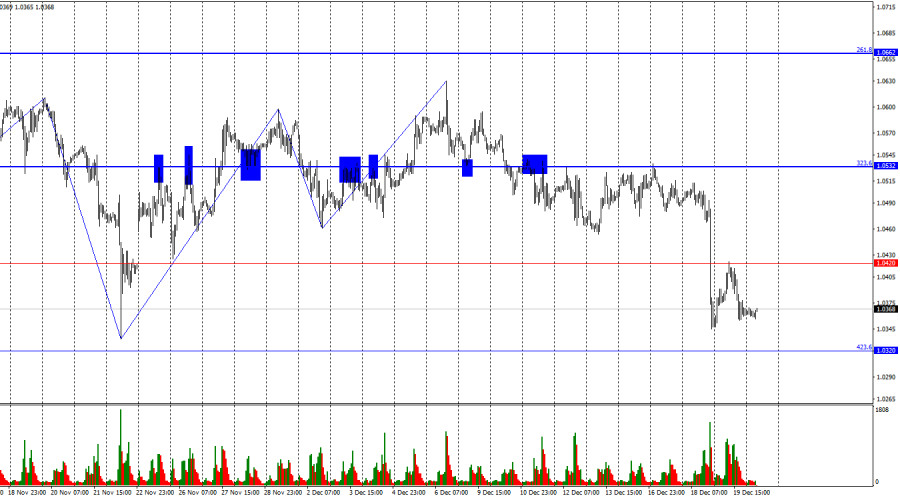Vea también


On Thursday, the EUR/USD pair rose to the 1.0420 corrective level, rebounded, and reversed in favor of the U.S. dollar. The downward process resumed toward the 423.6% corrective level at 1.0320. A rebound from 1.0320 could signal a reversal in favor of the euro and a rise toward 1.0420. However, a close below 1.0320 would increase the likelihood of further declines toward the next level at 1.0225 (4-hour chart).
The wave structure is simple and clear. The last completed upward wave barely broke the previous peak, while the last downward wave easily broke the previous low. This indicates that the formation of the "bullish" trend is now complete. As I previously suggested, it was weak. A further decline in the euro is expected as part of a new trend.
The information backdrop on Thursday was much weaker for both the euro and the dollar, yet the overall dynamic remained intact. Traders continue to process the outcomes of the Federal Reserve meeting. Although the euro saw a slight recovery, it quickly gave up its gains. In my view, global events such as the Fed meeting can influence trader sentiment for an extended period. Bears currently have informational support.
To recap, the Fed decided to cut rates again, but it signaled a strong likelihood of more pauses than rate cuts in 2025. Traders were not expecting that the FOMC would plan only two 0.25% rate cuts for 2025. This divergence between the ECB and Fed's rate policies could widen next year, further disadvantageing the euro. I believe bears will continue to dominate, and a move below 1.0320 is just a matter of time.
On the 4-hour chart, the pair has bounced twice from the 100.0% corrective level at 1.0603 and continues to decline toward the 161.8% Fibonacci level at 1.0225. A "bearish" divergence in the CCI indicator also pushed prices lower. A consolidation above 1.0436 could signal a recovery toward 1.0603. No new divergences are observed on any indicators today.
During the last reporting week, speculators closed 10,318 long positions and opened 7,766 short positions. The sentiment among the "Non-commercial" group remains "bearish" and is strengthening, suggesting further declines for the pair. The total number of long positions held by speculators is now 157,000, compared to 233,000 short positions.
For 13 consecutive weeks, major players have been offloading the euro. In my view, this indicates a "bearish" trend. The key factor behind the dollar's decline—expectations of Fed easing—has already been priced in. The market now has fewer reasons to sell the dollar. While these reasons might emerge over time, the U.S. dollar remains poised for further growth. Technical analysis also supports the start of a long-term "bearish" trend, and I expect the EUR/USD pair to experience a prolonged decline.
The economic calendar for December 20 contains a few moderately significant entries. The impact of these events on market sentiment is expected to be minimal.
Selling the pair was possible after a bounce from the 1.0603 level on the 4-hour chart, targeting 1.0420 and 1.0320. The first target has been met, and the second is nearly reached. Yesterday, sales were viable following a bounce from 1.0420 on the hourly chart. Buying will be possible if the pair bounces from 1.0320 on the hourly chart, though I would still avoid risking purchases at this time.
Fibonacci levels are plotted from 1.1003–1.1214 on the hourly chart and from 1.0603–1.1214 on the 4-hour chart.
You have already liked this post today
*El análisis de mercado publicado aquí tiene la finalidad de incrementar su conocimiento, más no darle instrucciones para realizar una operación.


Gráfico Forex
versión web

Your IP address shows that you are currently located in the USA. If you are a resident of the United States, you are prohibited from using the services of InstaFintech Group including online trading, online transfers, deposit/withdrawal of funds, etc.
If you think you are seeing this message by mistake and your location is not the US, kindly proceed to the website. Otherwise, you must leave the website in order to comply with government restrictions.
Why does your IP address show your location as the USA?
Please confirm whether you are a US resident or not by clicking the relevant button below. If you choose the wrong option, being a US resident, you will not be able to open an account with InstaTrade anyway.
We are sorry for any inconvenience caused by this message.



